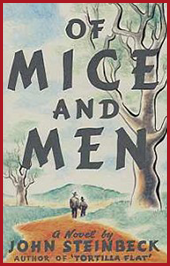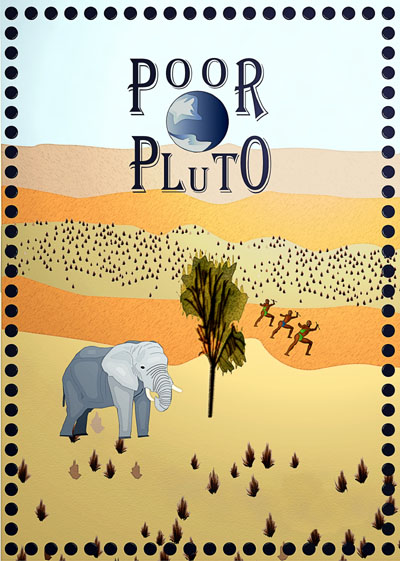Steinbeck, John (Covici Friede, 1937, ISBN (reprint) 9780749717100)
The educational films they showed us in middle school seemed all at least twenty-years old. On flickering projector film, scientists in brown suits took us on a tour of the body’s respiratory system while sanitised hipsters with pompadours showed us how to resist peer pressure. Crew-cutted schoolboys discovered the power of lunchroom manners while other sons and daughters of white hegemony learned how quiet helps at school. Deep-voiced fabulists sold us a version of the American legislative process with no pharmaceutical or energy lobbyists. Other narrators, whose measured delivery somehow conveyed the vastness of space, described the then nine planets of the solar system as the viewpoint swept out towards poor Pluto (of late expelled from the League of Planets for conduct unbefitting a solar planet).
In a grainy National Geographic film from the fifties we saw Bushmen of the Kalahari Desert hunt an elephant. To those of us inclined to sentimentalise the elephant, it seemed villainous. Whatever their actual character, elephants prevailed in our jejune sympathies as gentle creatures, even altruistic ones. Watching them hunt this uncomprehending behemoth felt like seeing them hunt Lennie down through the last pages of Of Mice and Men.
For most of the film, they tracked the elephant. For days they circled around, changing direction at each stripped tree, pile of dung or elephantine footprint. No doubt, in reality, tracking a ten-tonne creature over a featureless plain proves harder than it sounds, but it did put a note of suspicion into one’s mind. Time after time, we watched them wake, fill skins with water and spend the day reading the tracks, only to retire at sundown empty-handed. As time stretched on, it seemed less and less probable that they’d find the elephant.
And then, with no warning, it appeared in the shade of a solitary tree. The Bushmen, who before had seemed such masters of their environment, now looked tiny and defenceless; the elephant immense and unconquerable. No honest pundit would’ve given them much chance. Three nude men with sharpened sticks confronted an African bull elephant twice the size of any we’d seen in zoos.
Their attack, when it came, took some time even to get its attention.
Instead of fanning out, the Bushmen ranked up together to hurl their tiny spears in volleys. Their first three spears just rebounded off the elephant. The second volley managed to embed one into the rind of its hide for a few moments. The elephant looked up, saw them and went back to eating its tree. The spear fell out.
By the time they ran out of spears several volleys later, they had succeeded in annoying the elephant.
After several death-defying sorties to reclaim the spent spears (through which the elephant neither charged nor retreated), the Bushmen renewed their attack. It’d become patent that they would never succeed in administering any serious injury. It just remained for us to see if the elephant would trample one of them.
Then, as a new volley of spears glanced the elephant, the film jumped and it lay stone-dead on the ground. We watched them carve the carcass and carry bundles of meat back to their village.
Even as children we realised the film crew must’ve stopped filming and shot our elephant. But then, what had we seen the Bushmen doing? As soon as you saw them facing down the elephant, you knew this could never work. Not against an elephant half its size. Not if they’d brought twice as many hunters. Their village can’t have included elephants among its hunting targets. So how had three huntsmen with tiny javelins wound up leading a film crew across the savannah in search of one?
Could they’ve found themselves caught in a lie?
No doubt when they arrived in the village, National Geographic’s team had said that they’d come to find out what sorts of things people in this village did. It doesn’t seem too hard to imagine that some young man might’ve stepped up and announced that they hunted elephants.
“We’d love to see that!” said the anthropologists.
And perhaps before they knew it, they found themselves out on the plains trying to pick a fight with the savannah equivalent of a tiger tank.




Pingback: Bandwagon | Melbourne Review of Books